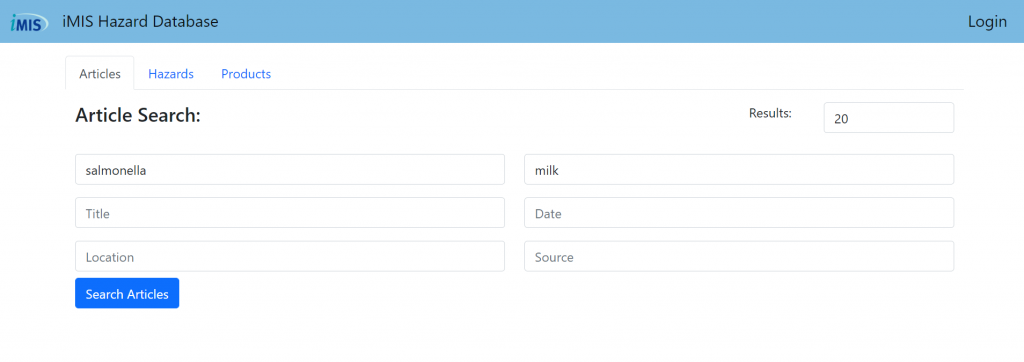Salmonella in Milk review
Researcher E.H. Marth a researcher has already stated in 1969 that salmonella can occur in raw milk in the Journal of Dairy Science, published by the Elsevier. Salmonellosis epidemics were caused by the consumption of contaminated unpasteurized milk (Marth, 1969). Milk that has been pasteurized has also contributed to the spread of these organisms, which originated in the product potentially contaminated after heating. Salmonellae have been identified in various dairy products in the United States and globally (Marth, 1969).
A range of pathogens that are occasionally detected in unpasteurized milk might cause illness. Brucella, Campylobacter, Cryptosporidium, E. coli, Listeria, and Salmonella are among these pathogens (CDC, 2017) Milk and dairy products are a vital part of the human diet since they contain all of the critical elements needed for bodily development. The contamination of milk and its products does not diminish their quality, but it does cause the transmission of pathogens (Singh et al., 2018).
Between 1993 to 2012, 127 incidents associated with raw milk were reported to the CDC. There were 1,909 illnesses and 144 hospitalizations related to these outbreaks (CDC, 2017). Campylobacter, Shiga toxin-producing E. coli, and Salmonella were responsible for the majority of outbreaks. A significant proportion of raw milk outbreaks include children (CDC, 2017). From 2007 to 2012, at least one kid less than 5 was involved in 59% of the raw milk outbreaks reported to the CDC. In these outbreaks, children aged 1 to 4 accounted for 38 per cent of Salmonella infections and 28 per cent of illnesses caused by Shiga toxin-producing E. coli, which may cause renal failure and death (CDC, 2017).
As most salmonella cases are linked to egg products or from an unknown origin, historical information has shown that milk and dairy products can be a good breeding ground for salmonella. According to the EFSA (2019), there have been 24 cases of salmonella contamination in 2018, other products and product groups linked to Salmonella can be seen on the link below. More information about Salmonella can be found on the Salmonella knowledge sheet.

Review Sources
- CDC (2017): https://www.cdc.gov/foodsafety/rawmilk/raw-milk-questions-and-answers.html
- EFSA. (2019). Foodborne outbreaks caused by salmonella in 2018. European Food Safety Authority. Retrieved June 1, 2022, from https://www.efsa.europa.eu/sv/foodborne-outbreaks-salmonella-2018
- Marth, E. H. (1969). Salmonellae and salmonellosis associated with milk and milk products. A review. Journal of Dairy Science, 52(3), 283-315.
- Singh, P., Singh, R. V., Gupta, B., Tripathi, S. S., Tomar, K. S., Jain, S., & Sahni, Y. P. (2018). Prevalence study of Salmonella spp. in milk and milk products. Asian Journal of Dairy and Food Research, 37(1), 7-12.
iMIS Records: Salmonella in Milk
The QAssurance Hazard database shows an overview of cases by looking up food safety cases. The following cases have been registered in the database. More information about the database will follow soon.

2000 consumers ill in the US by mr. Cheese
Hazard
Salmonella Newport
Product
Raw milk cheese
Date
2009
Location
Utah in the United States
Case
Possibly 2,100 people in the state of Utah (USA), became ill with Salmonella Newport since 2009 by contaminated raw milk cheese. Around Salt Lake City were attributed eleven infections in 2009, this type of cheese. Local authorities warned of the cheese, which was sold at malls including from the trunk of a car. In three years, the man-made 73 victims, but because of underreporting is the weekly number of probably thirty times higher. The man who bought the milk may be illegal at a local dairy.
Commentary
On December 1 2011 Mr Fidel Gomez (aka Mr Cheese) received from the authorities in Utah a fine of $500 for the illegal production and sale of cheese without a license and for selling cheese without a label. Given the seriousness of the facts, Mr Cheese came off it lightly.
Sources
Risk of disease much greater by raw milk
Hazard
Salmonella and Campylobacter
Product
milk
Date
2009-2014
Location
The United States
Cases Salmonella in milk
In the United States were reported from 2009 to 2014, 760 disease cases per year by unpasteurized dairy. The most common causes were Campylobacter and Salmonella. In the US, only 3.2% of the population consume unpasteurized milk and 1.6% consume unpasteurized cheese. Statisticians calculated that the probability was 840 times as much of getting ill from these products as of unpasteurized dairy. Concluding cases of dairy disease occur in 96% of cases due to unpasteurized dairy.
Commentary
One can wonder why no one has ever published anything in a scientific journal about how safe unpasteurized dairy is, but always about how not safe unpasteurized dairy is. The reason is, of course, that unpasteurized dairy is many times more unsafe. There has been a lot of scientific research into the nutritional values of unpasteurized dairy versus pasteurized dairy. It is clear that there is no difference in that area.
Source
Related articles to Salmonella in milk: Hazard history and records
Many customers and visitors to this page 'Salmonella in milk: Hazard history and records' also viewed the articles and manuals listed below:
